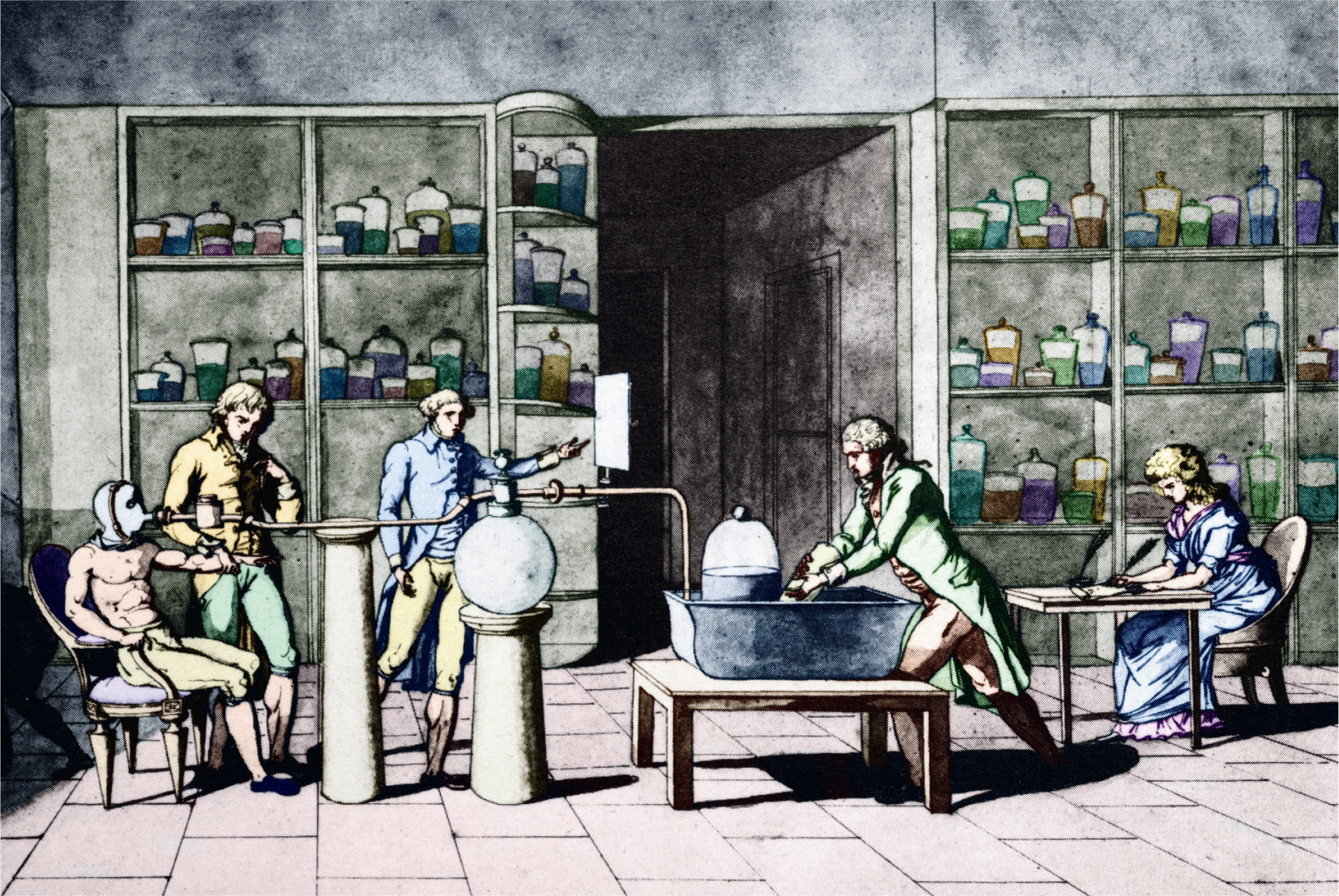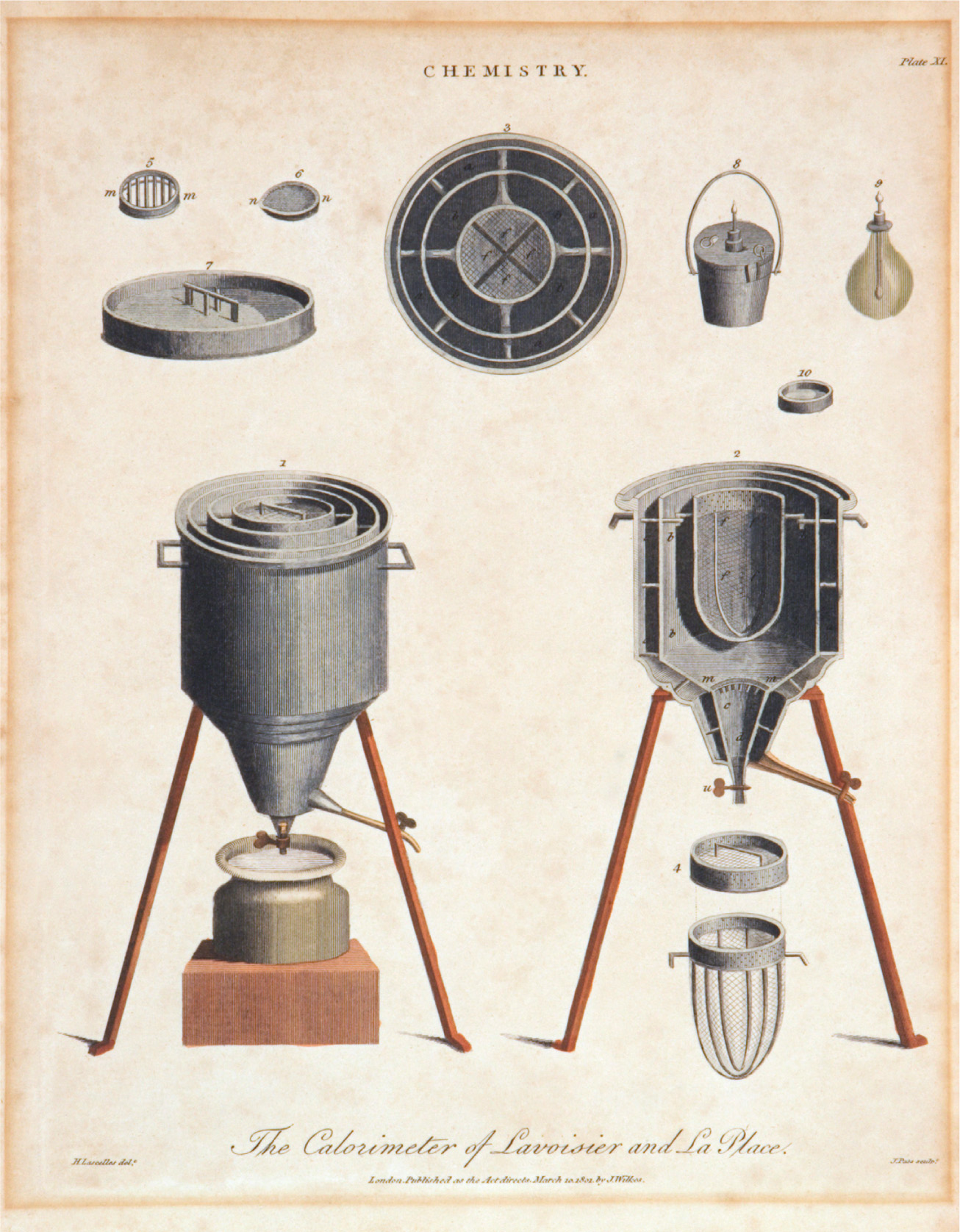
Antoine Lavoisier (1743–1794) in his laboratory with his wife and his assistants. His wife (Marie-Anne Pierrette Paulze, 1758–1836) is taking notes at far right.
Although earlier experiments, such as those of Priestley and Ingenhousz, had shown the importance of some component of air in maintaining life, at the beginning of the 1780s the details of the process were still far from clear. Like many of his colleagues, the French chemist Antoine Lavoisier, a member of the French Academy of Sciences, speculated that the process resembled a slow form of combustion, with the life-giving component of air being converted into ‘fixed air’ (carbon dioxide) by, in effect, being burned in the body. But unlike those colleagues, Lavoisier, together with his fellow acadamician Pierre Laplace, carried out a proper scientific experiment, based on quantitative principles, to test the hypothesis.
Their experiment involved a guinea pig, which was placed in a container within another container, itself insulated from the outside world, with the gap between the two containers filled with snow at 0 ºC. Under these conditions, the animal was quiet and did not move about much. They waited for ten hours, and collected and measured the water that had melted from the snow as a result of the warmth of the guinea pig’s body. It came to 13 ounces (369 grams). Then, in a separate series of experiments Lavoisier and Laplace measured how much fixed air the animal breathed out in ten hours while it was resting. Finally, they compared their guinea-pig measurements with the amount of snow that could be melted by burning enough charcoal to make the same amount of fixed air. This was slightly less than 13 ounces, but the agreement was close enough to convince Lavoisier and a wider circle of scientists that animals keep warm by combining the substance we now call carbon, obtained from their food, with something from the air (oxygen) to make fixed air (carbon dioxide). This was a key step in seeing animals, including human beings, as systems obeying the same laws as burning candles or falling stones.

It was Lavoisier who gave oxygen its name, and who established that burning does indeed involve oxygen from the air combining with the burning substance. This replaced the old idea, still adhered to even by people such as Priestley, that a substance called ‘phlogiston’ is escaping from the substance as it burns. Lavoisier published his definitive demolition of the phlogiston model in the Mémoires of the French Academy in 1786, using the term ‘air’ where we would say ‘gas’:
1 There is true combustion, evolution of flame and light, only in so far as the combustible body is surrounded by and in contact with oxygen; combustion cannot take place in any other kind of air or in a vacuum, and burning bodies plunged into either of these are extinguished as if they had been plunged into water.
2 In every combustion there is an absorption of the air in which the combustion takes place; if this air is pure oxygen, it can be completely absorbed, if proper precautions are taken.
3 In every combustion there is an increase in weight in the body that is being burnt, and this increase is exactly equal to the weight of the air that has been absorbed.
4 In every combustion there is an evolution of heat and light.9
Lavoisier also gave their modern names to many other substances, and produced the first list of 33 chemical elements, as well as introducing a system of symbols to represent the elements, although not all of them turned out to be elements as we know them today. The key point, though, is that he discarded the old idea of four mystical ‘elements’ (Earth, Air, Fire, and Water) and replaced it with the idea of an element as a substance that could not be broken down into any simpler substances using chemical processes, while more complex substances were made by combining elements. Indeed, Lavoiser’s definition still stands: ‘We must admit, as elements, all the substances into which we are capable, by any [chemical] means, to reduce bodies by decomposition.’ His naming system used logical rules based on this idea, so that, for example, ‘vitriol of Venus’ became ‘copper sulphate’.

His book Traité Éleméntaire de Chimie (Elementary Treatise on Chemistry) was published in 1789, and laid the foundations of chemistry as a proper scientific subject. It is seen by chemists as their equivalent to Isaac Newton’s Principia. Lavoisier also spelled out clearly what we now call the law of conservation of mass, which states that matter is neither created nor destroyed in chemical reactions, but only converted from one form into another. In the same year, he also founded a journal, Annales de Chimie, which carried research reports about the new science.
As far as such things can be pinned down to a specific year or a specific event, the publication of Lavoisier’s book marks the moment when chemistry shed the last traces of alchemy and magic, and became a proper scientific discipline.